CHANGING STEMS, CHANGING LEAVES
/0 Comments/in Design, Flowers, Fruit, Gardening, Planning/by Lee ReichKorean Giant Pear, In Training
Stepping down the two stones at one end of my bluestone wall, a friend looked up and asked, “Are you torturing or training this tree?” He was referring to the tree on one side of the the stairway, one long stem of which was arching overhead, held in that position with a string tied to a stone on the opposite side of the stairway.
“Training,” I replied. The stem was being coaxed into this seemingly submissive position both for form and function. Not to inflict pain.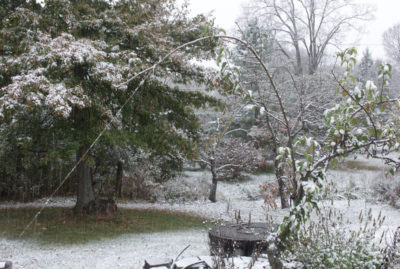
But first, something about this tree. It is an Asian pear, the variety Seuri Li that I created many years ago by grafting a Seuri Li stem on a semi-dwarfing rootstock (OH x F 513). It’s initial training was as an en arcure espalier. Deer found the young pear trees sitting high enough on the backfilled soil behind the wall a convenient smorgasbord; they didn’t even have to bend down to nibble at them. So the espalier became a deer-modified en arcure.
Seuri Li never bore as well as the other Asian pears — Yoinashi, Yakumo, and Chojuro — trained above that wall. Last year I lopped back one major stem of Seuri Li and grafted a stem of the variety Korean Giant onto the stump. The graft “took,” and fueled by the established root system, buds from the grafted stem soared skyward.
Growth from the graft was vigorous enough to start a large arch over the two stone stairway. A very big en arcure.
Hormonal Control
Training to en arcure entails bending the single stem of a young fruit tree over to its neighbor. Typically, a bud near the high point of the arch will grow out into a vigorous shoot which is then bent in an arch in the opposite direction, to its neighbor on the other side. The vigorous shoot growing from the high point of that second arch is trained back to the next tier of arch of first neighbor. And so on, as high as desired.
The end result is a flat plane of adjacent trees decoratively linked as a living fence.
The fence might be considered functional, but the truly functional aspect of en arcure is physiological. Enhanced vigor of the highest buds can be traced to a plant hormone, auxin. Auxin, present in all plants, is synthesized in the uppermost growing points of a plant, either the tip of a vertical stem or the high point of an arched stem. But this auxin also puts the brakes, to some degree, on growth from buds below that high point.
Growing fruit takes energy, as does growing stems; more fruit means less stem growth, and vice versa. (Left to their own devices, plants more or less balance these needs themselves, although not always to our satisfaction, which is why you have to pluck off peach fruitlets so that a peach tree can pump more energy into the fewer — and resulting — tastier fruits that remain.) Bending a branch over quells its growth, coaxing it to divert more energy to making fruit — except for the uppermost bud, which puts out a vigorous shoot.
My plan, then, is to have that long stem of Korean Giant pear festooned with flowers in spring and fruits in autumn as it arches over the stone stairs. Plants don’t read plant physiology books and tow the line to all this theory, but I’m confident in a fruitful, decorative future for my plant because Asian pears generally are very eager to bear fruit.
Uncommon Autumn Color
Speaking of physiology, I wrote last week about the carotenoids, tannins, and anthocyanins that make autumn so warmly colorful, and especially so this year here in the Hudson Valley. A few plants, not commonly planted, are contributing boldly to that warmth.
•Japanese Stewartia (Stewartia pseudocamellia) earns its keep year-round, with rich, red autumn leaf color right now, bark mottled in hues of gray and brown in winter, and camellia-like flowers in early summer.

Stewartia in autumn
•Fothergilla (Fothergilla major) also earns its keep for much of the year, with bottlebrush clusters of fragrant, white flowers in spring and leaves that turn brilliant shades of yellow, orange and red in autumn.
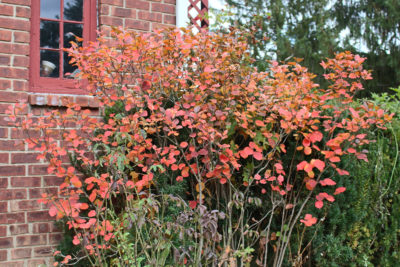
Fothergilla in autumn
•Korean mountainash (Sorbus aucuparia) bears flat-topped clusters of white flowers in spring. In autumn, leaves take on a yellow color enriched with some brown and hints of red. Clusters of red fruits also ripen in fall. They’re small, but edible, a nice nibble.
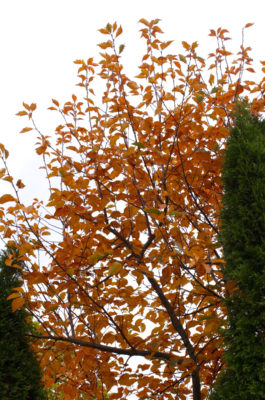
Korean mountainash in auatumn
•Pawpaw (Asimina triloba) bears large leaves that have lost their summer-y, tropical look and have turned a clear yellow. The large fruits, also with tropical aspirations, have been ripe for a few weeks, with flavors akin to vanilla custard, banana, or crème brûlée. Take your pick.
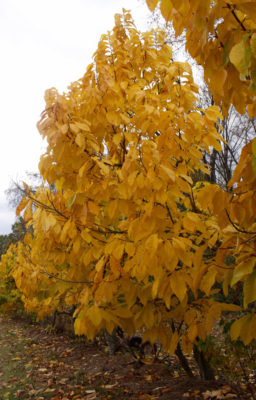
Pawpaw, autumn leaf color
THE GOOD AND THE BAD OF A DRY AUTUMN
/3 Comments/in Fruit, Gardening, Vegetables/by Lee ReichJust Like Korea?
The bone dry weather blanketing the Hudson Valley and much of northeastern U.S. does have its saving graces. For one thing, it forces perennial plants to shut down and direct their energies to toughening up for cold weather lurking over the horizon. That’s a good thing — unless, of course, the soil gets dry enough to kill a plant. Deciduous plants have the option, before that happens, to drop their leaves, drastically reducing their water loss and needs.
This dry autumn weather is not unlike that in many parts of Korea. So what? When it comes to cold-hardiness, some plants that survive Korea’s frigid winters typically are done in by our similarly frigid winters. One plant that comes to mind is Asian persimmon (Diospyros kaki). The chances of an Asian persimmon surviving a winter here at my Zone 5 farmden and ripening its fruits are generally not good. Autumn weather like this year’s ups the odds.
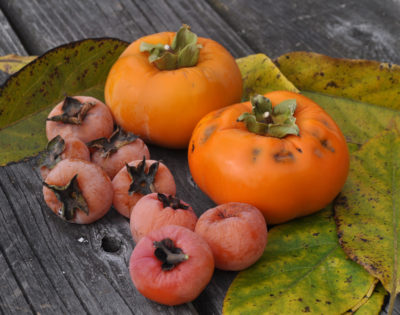
Asian & American persimmon, compared
(American persimmons (D. virginiana), on the other hand, easily survive, and varieties such as Szukis and Mohler reliably ripen their fruits here.)
Survival of an Asian persimmon here is very topical to me because I planted one this past spring. I did plant one of the most cold-hardy varieties, Great Wall. This variety is allegedly hardy and will ripen fruit in Zone 5 (at least that’s what Lee Reich wrote in the book Uncommon Fruits for every Garden). This autumn weather should help get it through its first winter here.
Autumn Color Chemistry
This bone dry weather has also made for glorious autumn leaf colors, even more than usual. Did I write, last year, that autumn color was the best ever, and the year before that, and . . . ? The reason for the exquisite color is physiological (the leaves’, not mine).
Leaves can, of course, be green. Other colors also figure in, obscured by the green of chlorophyll until autumn’s cooler weather and shorter days dissolve away the chlorophyll to let these other colors strut their stuff. Autumn’s fiery oranges and yellows, especially prominent in sugar maple, gingko, aspen, hickory, and beech, are from carotenoids. Tannins are another color component that get expressed in autumn; they give oaks their brown color, and enrich the yellow hues of beeches and hickories.
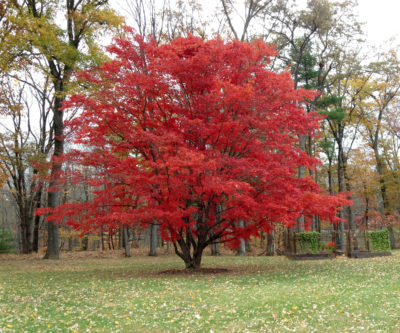
Japanese maple in autumn
Unless an early freeze burns off trees’ leaves while they are still green, those oranges and yellows and browns put on a reliable show every autumn, no matter what the weather.
Not so for the reds and purples of autumn leaves. These colors are expressed by anthocyanins, compounds which are not present or obscured by the green of chlorophyll during the growing season. Anthocyanins develop in autumn, and they need sugars for their development. Sugars come from photosynthesis, whose driving energy is sunlight.
So, less rain and more sunny weather means more photosynthesis, more sugars, and better red and purple color in such plants as blueberry, sourwood, scarlet oak, and sugar maple. A recent spate of warm days and cool nights enhances the whole effect, the warm days spurring photosynthesis and the cool nights slowing respiration to slow “burning” of sugars.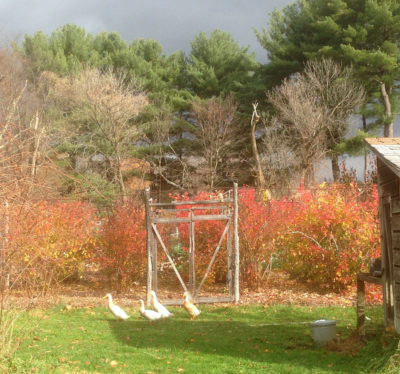
But How About Some Rain?
Much as I revel in day after day of clear, sunny weather and trees alive in color, I’d like a few heavy rains. The water supply of many homes on my road tap into shallow groundwater, the level of which is very low at this point.
Also, my drip irrigation system has been disconnected. The timer, the pressure reducer, and the filter, all of which must greet water as it comes out the spigot, before it enters the main lines, have been brought indoors to be protected from the recent freezing temperatures.
With reduced transpiration from cooler weather, autumn’s usual rainfalls can carry winter radishes, endive, Chinese cabbage, and other cool weather vegetables on a few more weeks until the end of the season. But we need these usual rains.
NUTTY TIMES AND COLD WEATHER
/9 Comments/in Flowers, Fruit, Gardening, Houseplants, Planning, Vegetables/by Lee ReichNuts Galore
What a nutty time of year, literally! Chestnuts and black walnuts, two of my favorite nuts, were raining down, figuratively, just before the middle of the month.
Black walnuts are free for the taking. Wild trees are everywhere around here, and keep increasing because of overlooked nuts buried by squirrels. The nuts are so abundant this year, and most years, that squirrels and humans can have their fill. (Not so with my filbert nuts; squirrels will strip those bushes clean.)
Black walnuts have a strong flavor. Like dark beer, fresh blackcurrants, and okra, not everyone likes the flavor. That’s fine. Fast food chains might purvey foods that everyone sort of likes, while a home gardener and gatherer can grow and gather fruits and vegetable and nuts that he or she really, really likes, and ignore what he or she really, really does not like.
There’s also, if you’re not a squirrel, the getting-to-the-nut problem with black walnuts. The first step is to remove it, as soon as possible after gathering the soft, messy, dark-staining husk. My wife, Deb, does this; I try and come up with contraptions to ease the job of husking 10 five-gallon buckets worth of nuts that eventually transmutes to 8 one-quart mason jars filled with nutmeats.
We’ve gone through a few incarnations of huskers. One year I bought an old fashioned corn husker, which needed some modification with an angle grinder. It didn’t do the job. Another year I ran the tractor back and forth over the nuts in the driveway, a common method, but not effective enough.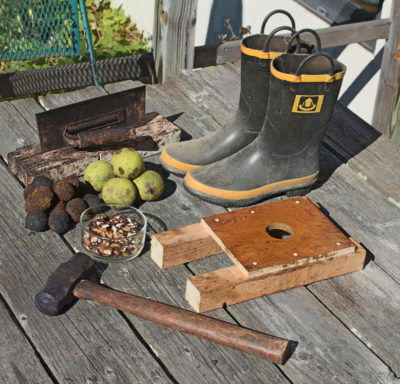
In years past, Deb has given each nut a tap with a light sledge hammer, which is enough to loosen the husk so it can be easily twisted off. Another year, I mounted a flat piece of metal in a slot I cut in a short length of 2-by-4 wood. Rolling the nut over the metal edge was enough to make the husk easy to twist off.
This year I drilled a nut-sized hole in a piece of wood and mounted it over a bucket. One whack with a light sledge hammer drove the nut through, minus the husk. Or, it was supposed to do that. One piece of husk, on the leading edge, alway stayed attached to the nut.
So now Deb is back to one of the standard methods for de-husking black walnuts: Stomp on them with your heel, then pick them off to rub off any remaining husk.
Readying for Cold Weather
Enough with the nuts . . . tonight (October 10th) temperatures are predicted to be in the low 30s, which means the high 20s in this cold spot. Mostly, I and the garden are ready for cold. Still to be done are:
•Close all hose spigots and open ends of drip emitters and main lines, watering wands, and hose sprayers to prevent the expansion of freezing water water from causing damage;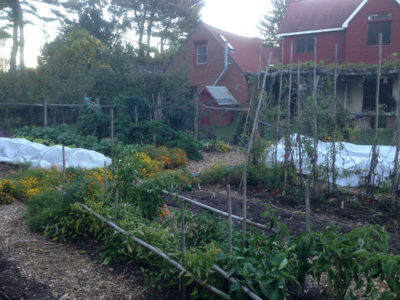
•Set up hoops and either clear plastic or row covers over beds of lettuce, Chinese cabbage, endive, arugula, and mustard greens. These vegetables tolerate temperatures well into the 20s, but I’ll cover them just in case. And they’ll anyway need the protective coverings soon;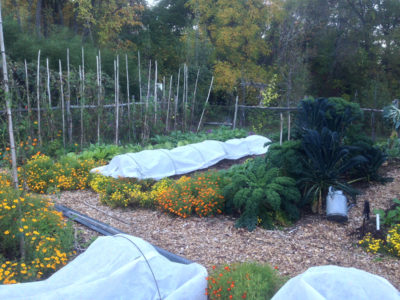
•Bring tropical plants indoors. Banana “trees,” staghorn fern, avocado, and clivia have laughed off cold so far, but tomorrow morning would not look so cheery if left outdoors. They get bright windows. A banana’s growing point is below ground which allows some gardeners to merely lop the whole top off the plant and store the bulb, in its pot, through winter under cool, dark conditions;
•Subtropical plants could survive temperatures into the 20s. I’m hoping for a crop from Golden Nugget mandarin, Meyer lemon, and Meiwa kumquat, so they’ve been walked indoors and perched near the most sun-washed windows in my house.
•Feijoa, olive, and Chilean guava are, like citrus, evergreen, subtropical plants, except they can tolerate colder temperatures than citrus. They sport neither fruits, flowers, nor flower buds now, so will remain outdoors until temperatures dip into the low 20s. Potted rosemary is also in this category; because I will be visiting it many times over the months that follow to clip off sprigs clipped for pizza and salad dressing, it’s new home is a sunny kitchen window.
•Basil will be dead tomorrow. Leafy stems picked today, their bottoms plunked into a glass of water, will provide fresh basil for a few weeks. Then it’s on to frozen basil pesto.
Cold Weather Takes a Rain Check, Without the Rain
The Morning After: No drama. That’s the way I like it. The slider on my min-max thermometer registered a low of 29° last night. A far cry from my first gardens, in Wisconsin, where it seemed every year (for the five I gardened there) around September 21st I would be wake to a frigid morning and a garden of blackened tomato, marigold, and pepper plants. This morning, marigolds and peppers have felt the chill, but live on to die slowly day by day as the sun dips lower in the sky and temperatures creep lower and lower.

